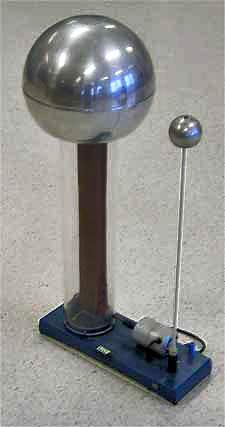
Van de Graaff Generator: Technical Summary
Principle of Operation
The Van de Graaff generator is an electrostatic machine that utilizes a moving belt to generate high voltage. The operation involves the following steps:
-
Triboelectric Effect: The belt, made of an insulating material, accumulates a charge on its inner surface due to frictional contact with the rollers.
-
Induction and Ionization: A comb-shaped electrode near the lower positive roller induces a high electric field at its points. This field ionizes air molecules, leaving behind positive ions that attach to the comb.
-
Charge Transfer: The positive ions on the comb charge the lower electrode attached to the terminal sphere, while the excess electrons on the belt discharge to the upper electrode connected to ground.
-
Electrostatic Induction: The positive charge on the terminal sphere induces an equal but opposite charge on the outer surface of the sphere, leaving no electric field inside.
-
Charge Accumulation: The continuous motion of the belt accumulates more charge on the terminal sphere, increasing its potential.
Voltage Limitation
The achievable voltage is limited by electrical breakdowns, known as corona discharge, in the surrounding gas. The breakdown field strength, which depends on the gas and its pressure, determines the maximum voltage that can be sustained.
Particle Acceleration
The high potential difference between the terminal sphere and ground provides an electric field that accelerates charged particles. By placing an ion source near the sphere, ions can be accelerated away from the terminal.
Tandem Accelerators
Tandem accelerators utilize two Van de Graaff generators arranged in series. In the first generator, negative ions are accelerated toward a high-voltage terminal. At the terminal, the ions are stripped of some electrons to become positively charged. They are then accelerated again away from the second terminal. This configuration effectively doubles the acceleration energy.
Pelletron
The pelletron is a variation of the tandem accelerator that uses a chain of metal spheres instead of a belt to convey charge. This design allows for higher voltages and greater current transmission.
Applications
Particle Accelerators: Van de Graaff generators have been used as particle accelerators in nuclear physics research, providing high-energy beams for studies of atomic and nuclear reactions.
Entertainment and Education: Small-scale Van de Graaff generators are used in museums, science shows, and schools to demonstrate electrostatic phenomena and produce spectacular electrical effects.
Advantages over Other Electrostatic Generators
Compared to other electrostatic generators, the Van de Graaff generator offers several advantages:
- Enclosed Charge Accumulation: The charge accumulation occurs inside the hollow spherical terminal, minimizing leakage and corona discharge.
- Continuous Charge Transfer: The belt allows for continuous charge transfer, reducing current limitations.
- High Voltage Capability: The spherical shape of the terminal and the enclosed charge accumulation enable the generation of very high voltages.